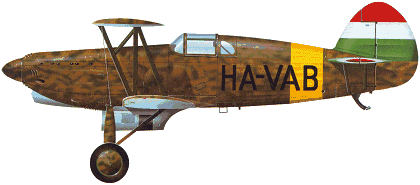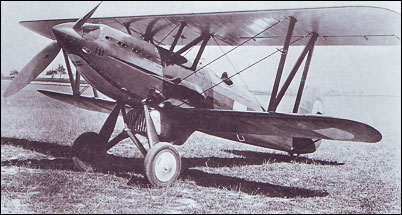|
| Probably the finest fighter biplane ever built, and one of the last mass-produced biplane fighters, the Avia B.534 first flew in August 1933, and an initial order for 100 machines was placed by the Czech Army Air Force. Early B.534s had an open cockpit, but a sliding hood was introduced on later aircraft. First deliveries were made in the second half of 1935. In 1937 a
B.534 took part in the International Air Meeting at Zurich and outperformed everything except the Messerschmitt Bf 109 - even then it was only 11km/h slower than the German fighter. The B.534 was adopted by the Czech Army Air Force as its standard fighter type, and also served in
Bulgaria and with the Luftwaffe, which used it as an advanced trainer. In 1939, after the German occupation of Bohemia and Moravia, large numbers of B.534s were acquired by the Slovak Air Force, which later used them against the Russians. Total B.534 production was 445 aircraft.

| ENGINE | 1 x 850hp Hispano-Suiza HS 12Y in-line engine |
| WEIGHTS |
| Take-off weight | 2120 kg | 4674 lb |
| DIMENSIONS |
| Wingspan | 9.40 m | 31 ft 10 in |
| Length | 8.20 m | 27 ft 11 in |
| Height | 3.10 m | 10 ft 2 in |
| PERFORMANCE |
| Max. speed | 394 km/h | 245 mph |
| Ceiling | 10600 m | 34800 ft |
| Range | 580 km | 360 miles |
| ARMAMENT | 4 x 7.7mm machine guns, 6 x 20kg bombs |
 | A three-view drawing (1668 x 1258) |
| James N. Clark, e-mail, 22.03.2013 17:53 The Bulgarian B.534s attempted to intercept USAAF B 24s returning from the low level raid on the oil refineries at Ploesti Romania. The B-24s however were by this time flying to high and fast to be successfully intercepted. reply |
| Ian Andrews, e-mail, 07.07.2011 17:42 To korfballjohn
The B-534 did not see combat in Czech markings, the Munich settlement prevented that. However it did see combat with the newly independent Slovak air force. It did badly against the Hungarians (with Fiat CR-32s) in March 1939, better against the Polish in Sept 1939 and quite well against the Soviets in 1941. It was however by then obsolete and also with lack of the rare BiBoLi fuel used in Czech aircraft, the aircraft were pulled back and used for training.
Germany seized the largest number of B-534s in 1939. For a few short months in the autumn of 1939 they equipped three fighter units; the 3. /Jagdgeschwader 70 (3. /JG 70), 1 and 3. /JG 71 and 4. /TrägerGruppe 186. The last of these was supposed to be a fighter squadron for the never completed Graf Zeppelin aircraft carrier. Although all of these units existed none saw combat. Most German B-534s then saw service as advanced trainers. But from 1941 they also saw front-line service as glider tugs, helping to resupply German units on the eastern Front.
Bulgaria also had a number of B-534, but due to their pro-Nazi neutrality they did not see any combat. A few were however used, mostly in a ground attack role when Bulgaria switched sides. Greece had two B-534s but they played no influential role before Greek defeat in 1941. The Soviets also had a few captured aircraft.
As briefly mentioned below, a B-534 flown by František Cyprich did see combat on 2nd Sept 1939 when as part of the Slovak National Uprsing it shot down a Hungarian Ju 52 /3m, becoming the last recorded biplane victory in history. reply |
| Barry, 25.11.2010 15:19 Developed by F.Novotny from his original design,the Avia B34, which was a radial engine fighter, the addition of the Hispano HS 12Ydrs and cleaning up of the lines produced this quite advanced biplane fighter. The four 7.92mm (modified Vickers)Mk30 machine guns were originaly fitted with two in the fuselage and two in the wings. However, the wing mounted guns caused significant vibration and so all subsequent models carried the armament in the fuselage.
The later Bk534 model was designed to have a 20mm cannon fire throgh the propellor hub, however, only a few were fitted and subsequent models had a machine gun fitted instead. reply | | korfballjohn, 04.11.2010 18:13 When I first saw the plane at Kbely, I had a double take and thought it was a Hurricane Bi-plane! Did they ever see service against their contemparies? reply | |
| | Anderson of Cove, e-mail, 20.08.2009 12:52 The B-534 pound for pound performance and abilities Places this as the best Biplane fighter ever built. Its records and pedigree prove the design was a flawless as a Biplane could be. I have spent most of my life evaluating Aircraft design. though the B-534 came in at the end its era had it been at the beginning or middle. its successor could have set the stage for the next generation being bounds ahead. reply |
| bsimonik, e-mail, 01.04.2009 17:09 To Jb
the comparement with thr Bf109 could be right. There is meaned the first versions of the Bf 109 (i.e. B) reply | | bsimonik, e-mail, 01.04.2009 17:05 This was the very last scoring biplane in the WWII reply | | DeAbajo, e-mail, 27.01.2009 09:25 I think on November 1938 already was not republican Spain, nor to mention the range of Avia, if this ever ocured, the pilot tried to escape from Czecoslovakia occupated by Nazi Germany via Romania or Yugoslavia (usual routes)...
Avia is last scoring byplane (pilot Cipro shot down Ju-52)
Regarding bomb loads 6 x 10 kg, 4 x 20 kg... :)
The 11 km faster was the value of average speed from the competition, not the value of max speed of the aircraft... reply | | Graziano, e-mail, 03.11.2008 16:17 I want notices photos info of the B-534 crash-landed in Tolmezzo (Italy) 14 november 1938, the pilot Ondrej Janata was in escape from Czechoslovakia to Republican Spain reply | | Jb, e-mail, 24.10.2008 00:26 The Fiat CR-42 and the Polikarov were excellent biplanes. Could I register my vote for the Gloster Gladiator though.
I can't believe that is was only 11 k /hr slower than the Meserschmitt 109. I think the difference was at least 80 km per hour. reply | | Francesco Fortunato, 29.07.2008 00:12 I Think that there are at least two other planes that can run for the best biplane fighter ever: they are the italian Fiat CR-42 and the soviet Polikarpov I-153. reply | | Martin Pener, e-mail, 11.11.2007 11:33 The armament was not 7,7mm machine guns, but (4 x) 7,92mm machine guns - czech (czechoslovac) type Vz.30 (= "Mark 30" or 1930).
Plane could wear only 4 x 10kg bombs or 4 x 20kg bombs.
The B.534 was also used in the Slovac national uprising (August - October 1944). reply |
|
Do you have any comments?
|
| 
All the World's Rotorcraft |








 Ian Andrews
Ian Andrews
These were not biplane Avia B-534, but monoplane Avia B-135
reply